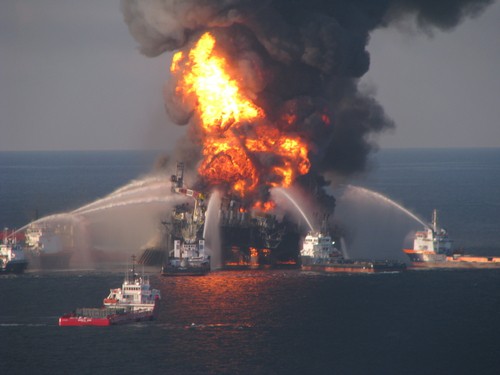 On April 20, 2010 an explosion and subsequent fire occurred on the Deepwater Horizon offshore drilling rig. It caused the rig to burn and sink resulting in a massive oil spill. What was initially a rescue operation became what is now considered to be the largest environmental disaster in U.S. history. The unit was operating in the Macondo Prospect oil field about 40 miles south of the Louisiana coast.
On April 20, 2010 an explosion and subsequent fire occurred on the Deepwater Horizon offshore drilling rig. It caused the rig to burn and sink resulting in a massive oil spill. What was initially a rescue operation became what is now considered to be the largest environmental disaster in U.S. history. The unit was operating in the Macondo Prospect oil field about 40 miles south of the Louisiana coast.
It was 10 p.m. on Tuesday night that the explosion rocked the Deepwater Horizon rig and the incident escalated into a massive rescue effort. The Coast Guard called in every available helicopter to begin a nighttime search of the gulf. Pilots were flying with night-vision goggles, and aircraft fitted with radar equipment that detected heat to aid in finding anyone in the water. There were 126 individuals aboard the rig, 115 of which were evacuated. Most used powered lifeboats and were taken on board by the M/V Damon B. Bankston, a workboat that British Petroleum had hired to service the rig.
When the helicopters arrived it was reported to have been like daylight within a half mile of the rig and the heat could be felt inside the aircraft. They began circling, looking for survivors not yet in lifeboats. They found none. They then lowered rescue swimmers to the lifeboats who triaged and the airlifting of the more severely injured to shore for medical attention began.
The Coast Guard Cutters Cobia and Zephyr arrived on scene and continued the search for survivors throughout the night. They were joined by an MH-65 helicopter and an HC-144 fixed-wing search aircraft at first light the next morning. The Cobia and Zephyr were relieved by the cutters Pelican and Coho that afternoon. On the 23rd the Coast Guard called off the search for the 11 people still missing, concluding that “reasonable expectations of survival” had passed. Rescue crews had covered the 1,940-square-mile search area by air 12 times and by boat five times.
Thursday morning the ‘Deepwater Horizon’ oil rig sunk into the Gulf of Mexico and the environmental implications from the explosion and fire became a much bigger issue.
Admiral Thad Allen who was to be relieved as Commandant of the Coast Guard and retire was selected by the Obama administration to oversee the government response to the ever increasing oil spill. He immediately began coordinating with officials of more than a dozen agencies along the Gulf Coast and in Washington. Problems arose immediately because it is most difficult to coordinate without authority. He found his challenges to be technical, environmental, political and coping with the glare of media scrutiny.
Under a 1990 law known as the Oil Pollution Act, BP as the responsible party initially took the lead. This brought up the question of self interest and as the problem increased exponentially a myriad of government agencies became involved many of which were engaged in self interest. In many cases the people making decisions were academics with little or no experience in the oil drilling industry. If it appeared that there was no one in charge it was because there was no one in charge.
BP’s had planned to permanently seal the well by drilling a relief well but was delayed. The oil flowed for three months significantly affecting the environment while several temporary methods to stop the flow were attempted. The first relief well began drilling on May 2, and the second began on May 16. On September 15, the first relief well successfully intersected with the blown-out Macondo well at 17,977 feet. The next day, BP began pumping cement into the stricken well to permanently seal it. On September 19 BP declared that the well had been successfully sealed. BP then announced that it would proceed to complete the abandonment of the MC252 well, which includes removing portions of the casing and setting cement plugs. A similar plugging and abandonment of both relief wells was completed.
The cause of the explosion was determined to be a new procedure; lack of communications and follow up. Both BP and Transocean, the driller were faulted. The environmental and economic impact of the spill was severe.
Time has shown that ADM Allen, who was directed to coordinate but given no authority to conduct the operation, did the best that could be done given the circumstances. He strongly recommended that a person well versed in oil drilling operations, who has no fiduciary ties to the industry, be assigned on a permanent basis and be given the authority, to effectively address any future oil spill mishaps. Politics and self interest and in some instances ideology will make this difficult to achieve.
